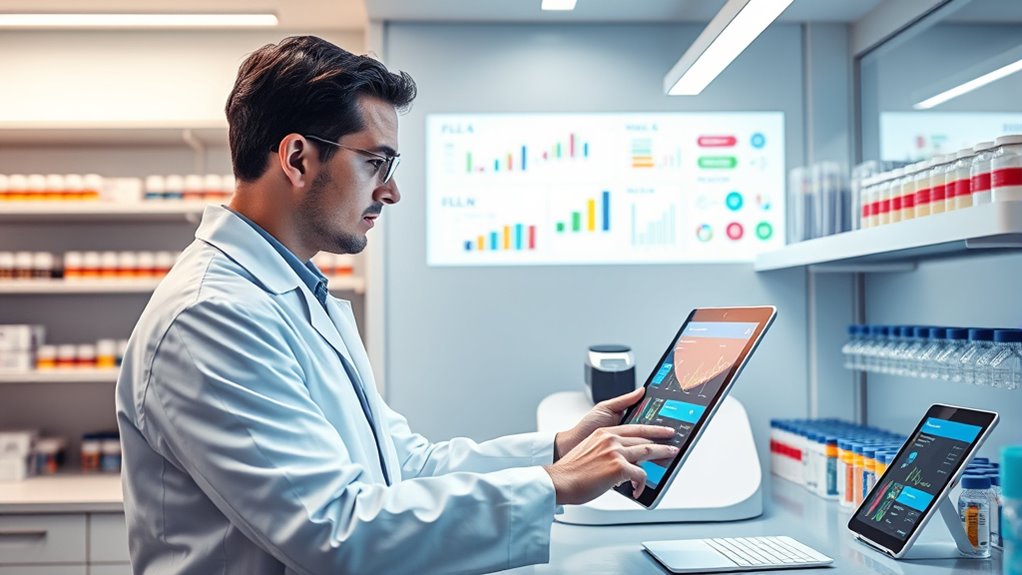To build a data-savvy lab, start by implementing a Laboratory Information Management System (LIMS) to organize samples and workflows, ensuring data integrity and compliance. Use Electronic Lab Notebooks (ELNs) to promote transparency, collaboration, and consistent documentation across your team. Adhere to FAIR principles by standardizing data formats and enhancing discoverability and reusability. Taking these steps lays a solid foundation; exploring further will help you optimize your lab’s data management practices even more.
Key Takeaways
- Implement a Laboratory Information Management System (LIMS) to centralize sample tracking, data storage, and workflow management.
- Adopt Electronic Lab Notebooks (ELNs) for transparent, standardized documentation and seamless collaboration among team members.
- Follow FAIR principles to make data Findable, Accessible, Interoperable, and Reusable for enhanced research reproducibility.
- Establish standardized procedures for data entry, storage, and sharing to ensure accuracy and consistency across projects.
- Promote a data-driven culture by training staff on data management best practices and leveraging digital tools for efficient workflows.

Creating a data-savvy lab begins with recognizing the significance of integrating data-driven practices into every aspect of your research environment. Central to this effort is effective data management, which ensures that your data is organized, accurate, and accessible. When you prioritize data management, you lay the foundation for seamless collaborative workflows. Instead of scattered files and inconsistent formats, you establish standardized procedures for data entry, storage, and retrieval. This consistency allows your team to share information effortlessly, reducing errors and saving time. Implementing Laboratory Information Management Systems (LIMS) can streamline this process, providing a centralized platform to track samples, manage workflows, and maintain data integrity. With LIMS, everyone on your team can access real-time data, update records, and guarantee compliance with regulatory standards. It turns your raw data into a dependable resource that supports decision-making at every stage of research. Additionally, training your staff to understand and utilize data governance practices ensures long-term data quality and security.
Beyond data management, fostering collaborative workflows is essential to building a data-savvy environment. You want your team to work cohesively, with data flowing smoothly between members and departments. To achieve this, encourage open communication and the use of digital tools that promote transparency. Electronic Lab Notebooks (ELNs) play a vital role here, allowing researchers to document experiments, share protocols, and review results in a centralized digital space. This transparency minimizes redundant efforts and accelerates troubleshooting. When everyone uses the same ELN platform, it’s easier to track progress, maintain version control, and guarantee data consistency across projects. Collaboration becomes more intuitive, and your team can build on each other’s work rather than reinventing the wheel.
In addition, adopting the FAIR principles—Findable, Accessible, Interoperable, and Reusable—guides your lab toward better data stewardship. By making data easy to locate, understand, and reuse, you foster a culture of openness and cooperation. Integrating these principles into your data management and workflows ensures that your data isn’t just stored but optimized for future research and collaboration. When your data is FAIR-compliant, external partners or future team members can quickly find and interpret your datasets, enhancing reproducibility and accelerating discoveries. Emphasizing standardized procedures and consistent data formats is crucial for maintaining FAIR compliance and maximizing data utility.
Frequently Asked Questions
How Do I Choose the Right LIMS for My Lab?
To choose the right LIMS for your lab, start by analyzing your laboratory workflow and identifying specific needs. Look for a system that seamlessly integrates with your existing instruments and software, ensuring smooth system integration. Consider scalability and user-friendliness to support your team’s growth and efficiency. Evaluate vendor support and customization options, so your LIMS aligns perfectly with your lab’s unique processes and data management goals.
What Are the Costs Associated With Implementing an ELN?
Thinking implementing an ELN costs just a few bucks? Think again. Cost considerations include licensing fees, customization, and ongoing support, which can add up fast. Integration challenges might mean extra expenses for syncing with existing systems or training staff. While it’s tempting to overlook these costs, neglecting them could turn your sleek new ELN into a costly paperweight. Prepare for the real price tag before diving in.
How Can FAIR Principles Improve Data Sharing?
FAIR principles enhance data sharing by promoting data interoperability and ethical data sharing. When you follow FAIR, your data becomes easily findable, accessible, interoperable, and reusable. This encourages collaboration, allowing others to seamlessly integrate and analyze your data. By emphasizing transparency and respecting privacy, FAIR principles guarantee data sharing remains ethical, fostering trust and accelerating scientific progress while maximizing the value of your data across the research community.
What Training Is Needed for Staff to Adopt New Systems?
You’ll need staff education and all-encompassing training programs to embrace new systems. Expect to turn skeptics into believers through hands-on workshops, online modules, and ongoing support. Make training engaging, not a chore, or risk a revolt. Cover system navigation, data management, and FAIR principles. This way, your team becomes confident, efficient, and enthusiastic about the digital transformation, ensuring smooth adoption and maximizing your lab’s data potential.
How Do I Measure the Success of a Data-Savvy Laboratory?
You measure your lab’s success by monitoring data quality and user engagement. High data quality indicates reliable, accurate results, while increased user engagement shows staff effectively adopt systems like LIMS and ELN. Track key metrics such as data consistency, completeness, and system usage rates. Regular feedback sessions also help you gauge how well your team integrates these tools, ensuring continuous improvement and a truly data-savvy laboratory.
Conclusion
Think of your lab as a well-tuned orchestra, where LIMS, ELN, and FAIR principles are your instruments. When each part plays in harmony, data flows smoothly, and discoveries become melodies rather than noise. By integrating these tools and principles, you’re composing a symphony of efficiency and insight. Keep tuning your instruments, and soon, your lab will produce a masterpiece of data-driven innovation—music that resonates far beyond your walls.









